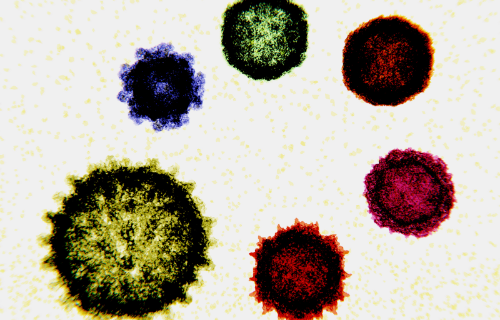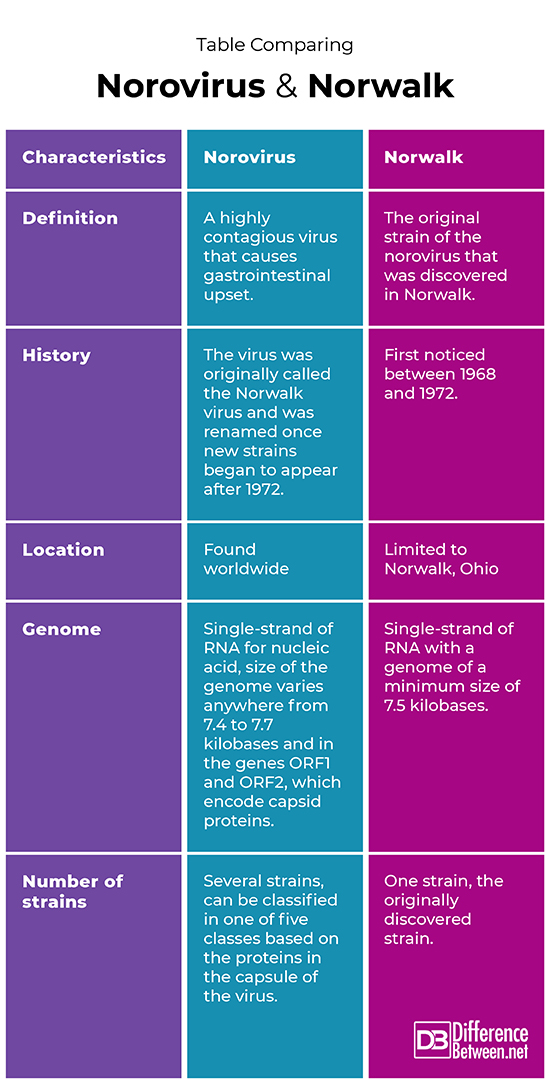Difference Between Norovirus and Norwalk
Norovirus is a type of virus that causes a contagious gastrointestinal problem. Norwalk is the originally discovered strain of the norovirus.

What is Norovirus?
Definition:
Norovirus is a virus that causes a contagious type of gastrointestinal illness.
Genome and strains:
Norovirus is a term used to describe several strains of virus that cause a severe form of stomach upset. The term also includes the original strain of the virus, the Norwalk virus. The norovirus strains today are known to vary in the genes ORF1 and ORF2. These particular gene sequences are responsible for making proteins on the viral capsid. As the genes mutate, so the viral capsids change, resulting in new strains.
Causative factors and transmission:
The virus is highly contagious and is caught from a person who is ill and actively shedding virus particles through vomiting and diarrhea. The virus spreads fast and people can quickly and easily catch the virus from contaminated surfaces in the environment as well as from sick people. People living in close contact are most likely to catch norovirus.
Diagnosis:
Often the symptoms suggest that the person has norovirus, especially if they are in close contact with other individuals who are sick. The only definitive diagnosis is made with a molecular RT-PCR test where the genetic material of the virus is tested for in a stool specimen.
Symptoms and complications:
Symptoms of norovirus include painful stomach cramps, diarrhea and severe vomiting, which lasts for anywhere from one day to about three or four days. Complications include dehydration, which can cause low blood pressure and even death. It does cause about 200,000 deaths world-wide, and thus, it should be taken seriously.
Treatment:
The person may need to be given medicine to stop diarrhea and vomiting. In severe cases, intravenous fluids need to be given to replenish the fluids lost from the body and to reverse the dehydration that results.

What is Norwalk?
Definition:
A virus that was discovered in 1968 in Norwalk, Ohio, which causes severe gastrointestinal illness.
Genome and strains:
The Norwalk virus had a genome of no smaller than 7.5 kilobases in size. This was the original strain around in the late 1960s and early 1970s.
Causative factors and transmission:
Norwalk virus is a type of norovirus that was easily transmitted among people, causing many to become ill with symptoms of gastrointestinal distress.
Diagnosis:
Diagnosis was based on the symptoms that people had. The original strain, Norwalk caused an outbreak that occurred before molecular biology techniques had been inventing, limiting diagnosis of the condition.
Symptoms and complications:
Symptoms were likely stomach upset including vomiting and diarrhea along with painful stomach cramps. Complications of Norwalk would be like all noroviruses, namely dehydration, hypotension, and possibly, death.
Treatment:
Treatment was likely to have been rehydration because people would have become dehydrated from the stomach upset.
Difference between Norovirus and Norwalk
Definition
Norovirus is a an extremely contagious virus that causes gastrointestinal upset. Norwalk is the original and first strain of the norovirus that was discovered in Norwalk.
History
Norovirus is a name used to describe a group of viruses with the original virus called Norwalk virus; the name norovirus was adopted post-1972 after the discovery of more strains of the virus. The Norwalk virus was first noticed sometime between 1968 and 1972 in Norwalk, Ohio.
Location
The norovirus is found causing outbreaks all over the world in several countries. The Norwalk virus was responsible for an outbreak in the city of Norwalk in the United States.
Genome
The genome of the norovirus consists of a single-strand of RNA and the size of the genome varies anywhere from 7.4 to 7.7 kilobases; there is variation in the genes ORF1 and ORF2, which code for the capsid proteins. The genome of the Norwalk virus consists of a single-strand of RNA with a genome of a minimum size of 7.5 kilobases.
Number of strains
There are several strains of the norovirus because of changes in the genes ORF1 and ORF2, which influences the viral proteins of the capsid. There is one strain of the Norwalk virus.
Table comparing Norovirus and Norwalk

Summary of Norovirus and Norwalk
- The Norwalk virus is the original strain of the norovirus.
- The norovirus is a very contagious pathogen that causes gastrointestinal upset.
- There are several strains of the norovirus today, occurring worldwide.
FAQ
Why is norovirus named after Norwalk?
This is because the first time the virus was discovered was in Norwalk, Ohio, so the illness was named after this city.
Is there another name for norovirus?
The other name that is not often used is Norwalk virus. Generally, this name is used for the first, original strain of the norovirus, which was discovered in the late 1960s.
What does the Norwalk virus mean?
This is the name used to describe the original norovirus strain that was found in Norwalk, Ohio.
How serious is the Norwalk virus?
It can be serious because it puts the person at risk of dehydration, which can be dangerous.
- Difference Between Rumination and Regurgitation - June 13, 2024
- Difference Between Pyelectasis and Hydronephrosis - June 4, 2024
- Difference Between Cellulitis and Erysipelas - June 1, 2024
Search DifferenceBetween.net :
Leave a Response
References :
[0]Conly, J. M., and B. L. Johnston. "Norwalk Virus--Off and Running." Canadian Journal of Infectious Diseases 14.1 (2003): 11-13.
[1]Karst, Stephanie M., et al. "Advances in norovirus biology." Cell host & microbe 15.6 (2014): 668-680.
[2]Lee, Bonita E., and Xiao-Li Pang. "New strains of norovirus and the mystery of viral gastroenteritis epidemics." CMAJ 185.16 (2013): 1381-1382.
